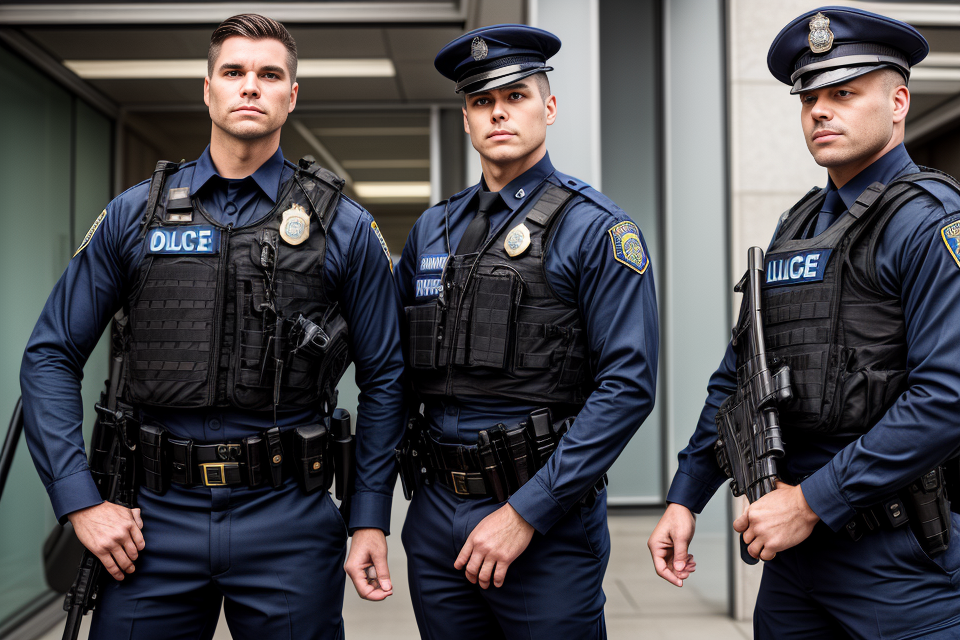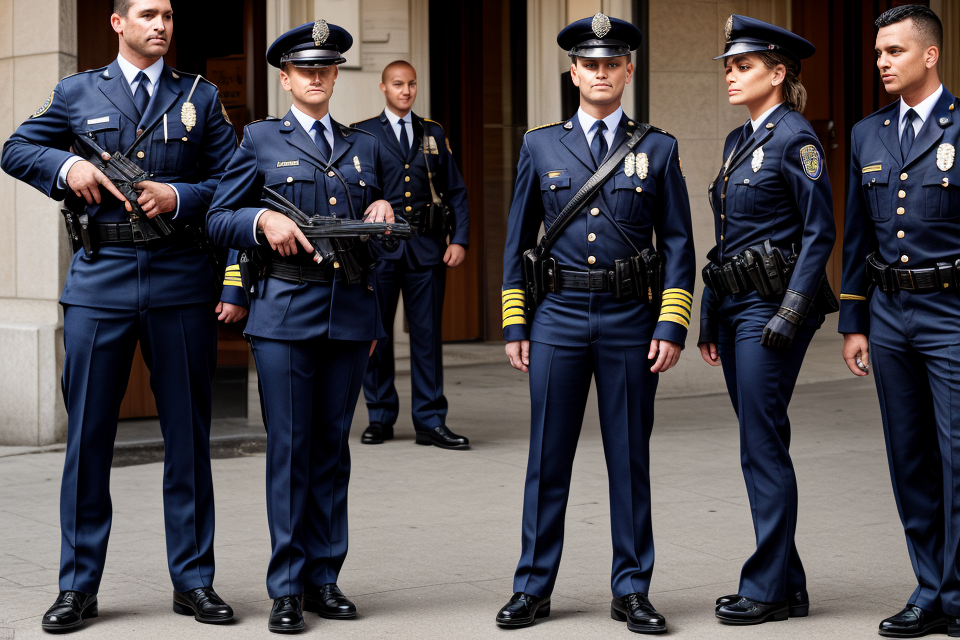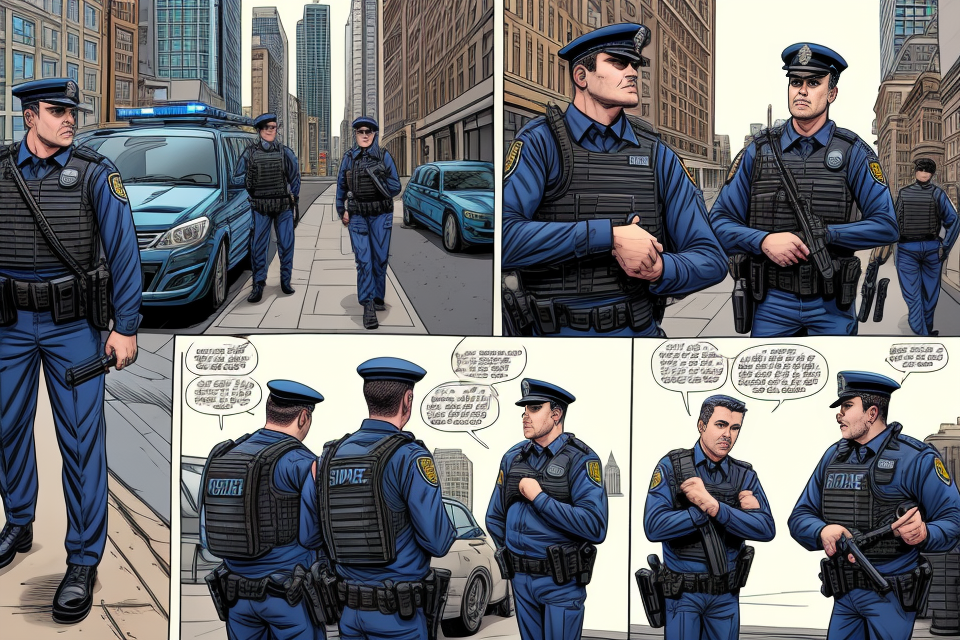
When it comes to law enforcement, most people expect to see officers dressed in their official uniforms, complete with a badge, hat, and reflective vest. However, there are some officers who choose to wear normal clothes instead of their standard issue uniforms. But why? In this article, we will explore the reasons behind this decision and examine the different types of law enforcement uniforms. From plainclothes detectives to undercover officers, we will delve into the pros and cons of wearing normal clothes as a police officer. So, let’s dive in and discover why some cops opt for a more low-key look.
Some police officers wear normal clothes as part of their undercover or plainclothes assignments. These assignments involve working in environments where uniformed officers would be conspicuous or would not be able to effectively carry out their duties. In these situations, officers may wear clothing that is similar to that worn by civilians in order to blend in and gather information or make arrests without drawing attention to themselves. Additionally, some police departments may use plainclothes officers to work on specialized units, such as drug enforcement or intelligence gathering, where the need for a more low-key appearance is necessary.
Understanding Law Enforcement Uniforms
The History of Police Uniforms
Origins of Police Uniforms
The origins of police uniforms can be traced back to the early 19th century when law enforcement agencies began to establish a more professional image. The first known police uniform consisted of a dark blue coat and pants, a white shirt, a black tie, and a peaked cap. This uniform was designed to give the police a distinct appearance and to symbolize their authority and power.
Evolution of Police Uniforms
Over time, police uniforms have evolved to reflect changes in law enforcement tactics, technology, and social attitudes. In the early 20th century, many police departments began to replace their traditional uniforms with more practical clothing that was better suited for the demands of patrol work. This included the introduction of the classic “blue serge” uniform, which consisted of a double-breasted tunic, trousers, and a peaked cap.
In the 1960s and 1970s, there was a movement towards more casual and informal police uniforms, which were seen as less intimidating and more approachable by the public. This led to the development of “community-oriented policing” uniforms, which often included khaki-colored shirts and pants, as well as more practical footwear such as sneakers or boots.
Today, police uniforms continue to evolve and adapt to changing times and circumstances. Many police departments have begun to experiment with more “non-traditional” uniforms, such as those that incorporate body armor and tactical gear, to better equip officers for the challenges of modern law enforcement.
Types of Law Enforcement Uniforms
Traditional Police Uniforms
Traditional police uniforms are the most common type of law enforcement uniforms. They consist of a button-up shirt, a tie, a jacket, and slacks or a skirt. The shirt typically has a button on the front with a pocket on each side for holding the badge and other police equipment. The jacket is often black and may have epaulets on the shoulders. The slacks or skirt are typically a standard dark color, such as navy blue or black. The uniform also includes a cap or hat, which is usually a standard issue item that must be worn at all times while on duty.
Specialized Uniforms
Specialized uniforms are designed for specific law enforcement roles. For example, SWAT teams and tactical officers often wear body armor and helmets in addition to their regular uniforms. These specialized uniforms are designed to provide extra protection and allow for easier movement during high-risk operations. Other specialized uniforms include those worn by police dogs, horseback officers, and bicycle patrols. These uniforms are typically designed to be more functional and comfortable for the specific needs of the job.
Overall, law enforcement uniforms serve as a symbol of authority and help to identify police officers as such. While traditional police uniforms are the most common, there are many different types of specialized uniforms designed for specific roles and duties within law enforcement.
The Need for Non-Traditional Uniforms
Situations Requiring Disguise
Police officers are often required to engage in operations that necessitate the use of non-traditional uniforms. In some situations, wearing a standard police uniform may compromise the effectiveness of the operation or put the officer’s safety at risk. The need for non-traditional uniforms arises from various circumstances, including undercover operations and surveillance and observation.
Undercover Operations
Undercover operations involve police officers disguising themselves as civilians to gather information or apprehend criminals. In these situations, wearing a police uniform would immediately identify the officer as a law enforcement official, potentially foiling the operation. By wearing normal clothes, officers can blend in with the surroundings and gain access to locations where they might not be allowed or welcomed if they were in uniform. This approach also enables officers to gather information and build cases without alerting suspects to their presence.
Surveillance and Observation
In some cases, police officers need to observe and monitor suspicious activities without drawing attention to themselves. Wearing a police uniform may deter individuals from engaging in criminal behavior, as they may be more likely to commit illegal acts if they believe they are not being watched. By wearing normal clothes, officers can blend in with the environment and observe activities without being noticed. This technique is particularly useful in areas with high foot traffic, such as shopping centers or public transportation hubs, where it is essential to maintain a low profile while gathering intelligence.
In conclusion, the need for non-traditional uniforms arises from situations that require police officers to remain inconspicuous or gain access to locations where they would otherwise be identified as law enforcement officials. By wearing normal clothes, officers can effectively carry out undercover operations and surveillance, ensuring the safety of the public and the success of their missions.
Enhancing Community Relations
- Building Trust and Rapport
- Avoiding Intimidation
Building Trust and Rapport
One of the primary reasons why some law enforcement officers choose to wear normal clothes instead of traditional uniforms is to build trust and rapport with the community they serve. In many cases, a uniform can create a barrier between the police and the public, making it difficult for people to feel comfortable approaching an officer or reporting a crime. By dressing in non-traditional attire, officers can blend in with the community and create a more approachable atmosphere.
Avoiding Intimidation
Another benefit of officers wearing normal clothes is that it can help to avoid intimidation. A police uniform often connotes authority and power, which can be intimidating to some individuals, particularly those who have had negative experiences with law enforcement in the past. When officers dress in civilian clothing, they may be perceived as less threatening, which can make it easier for people to feel comfortable speaking with them and reporting crimes or incidents.
In addition to building trust and rapport and avoiding intimidation, there are other reasons why some law enforcement agencies choose to use non-traditional uniforms. For example, undercover officers may need to blend in with the community in order to successfully carry out their duties, and plainclothes officers may be used to conduct investigations or provide covert surveillance. Ultimately, the decision to use non-traditional uniforms depends on the specific needs and goals of the law enforcement agency, as well as the community they serve.
The Pros and Cons of Wearing Normal Clothes
Advantages of Wearing Normal Clothes
Enhanced Visibility and Accessibility
One of the primary advantages of wearing normal clothes as a police officer is the enhanced visibility and accessibility it provides. Unlike traditional police uniforms, which can be quite distinctive and intimidating, normal clothes blend in with the surroundings and create a less confrontational atmosphere. This approach allows officers to more easily engage with the public and establish a sense of trust and rapport, which can be crucial in situations where cooperation is essential.
Greater Flexibility and Mobility
Another advantage of wearing normal clothes is the greater flexibility and mobility it offers. Police officers who wear regular clothing can more easily move around and navigate their environment, which can be especially important in situations where quick movement is necessary. Additionally, normal clothes do not impede an officer’s ability to perform physical tasks or engage in hand-to-hand combat, making it a more practical choice for many law enforcement situations.
Increased Safety and Security
Wearing normal clothes can also increase safety and security for police officers in certain situations. By blending in with the surrounding environment, officers can avoid drawing attention to themselves and reduce the risk of being targeted by criminals. Additionally, normal clothes can provide an added layer of protection in situations where an officer is undercover or attempting to infiltrate a criminal organization. Overall, the advantages of wearing normal clothes for law enforcement officers are numerous and can greatly enhance their ability to perform their duties effectively.
Disadvantages of Wearing Normal Clothes
Reduced Authority and Authority Figures
When law enforcement officers wear normal clothes, they are not easily identifiable as police officers. This can lead to a reduction in the authority figures that police officers are expected to have in their communities. The absence of a distinct uniform can lead to confusion and misunderstandings about who has the power to enforce the law.
Difficulty in Identification and Recognition
One of the main disadvantages of wearing normal clothes is that it can be difficult for members of the public to identify and recognize law enforcement officers. Without a uniform, it can be difficult to distinguish between law enforcement officers and civilians, which can create confusion in situations where quick identification is necessary.
Potential for Misidentification and Confusion
In situations where misidentification and confusion can have serious consequences, such as during a crime investigation or a high-speed chase, the lack of a distinct uniform can be particularly problematic. Law enforcement officers who are not easily identifiable may be mistaken for criminals or other individuals who are not authorized to carry out law enforcement activities. This can lead to misunderstandings and conflicts that can put the safety of both law enforcement officers and members of the public at risk.
Balancing the Need for Uniformity and Normalcy in Law Enforcement
Adopting a Case-by-Case Approach
In law enforcement, the decision to wear normal clothes instead of traditional police uniforms is often a case-by-case decision. This approach allows for more flexibility in situations where a uniform may be seen as too conspicuous or may draw unwanted attention. For example, undercover officers may need to blend in with the general population to gather intelligence or make arrests, and wearing normal clothes can help them do so without arousing suspicion.
The Future of Law Enforcement Uniforms
As law enforcement agencies continue to evolve, the role of uniforms in police work may change as well. Some experts predict that the use of traditional police uniforms may decline in favor of more practical, functional clothing that allows officers to move more freely and efficiently. This could include clothing made from lightweight, breathable materials that provide both comfort and protection.
Importance of Adaptability and Flexibility in Police Uniforms
Law enforcement agencies must balance the need for uniformity with the need for adaptability and flexibility in their officers’ clothing. In some situations, traditional police uniforms may be necessary to establish authority and maintain order. In other situations, however, normal clothes may be more appropriate to allow officers to blend in and gather intelligence or make arrests without drawing attention. The key is to strike a balance between these two needs, depending on the specific circumstances of each case.
FAQs
1. Why do some cops wear normal clothes?
Answer: There are a variety of reasons why some law enforcement officers may choose to wear regular clothing instead of a traditional police uniform. One reason is that undercover officers may need to blend in with the general population in order to carry out their duties effectively. Additionally, some community policing programs involve officers working in plainclothes in order to build trust with the community and gather intelligence. Finally, some law enforcement agencies may allow officers to wear street clothes as a form of professional attire when they are not on duty.
2. Are there any disadvantages to wearing regular clothes as a cop?
Answer: There can be some potential drawbacks to wearing regular clothes as a law enforcement officer. For example, it may be more difficult for the public to identify an officer who is wearing regular clothing, which could lead to confusion or misunderstandings. Additionally, an officer in plainclothes may not have the same level of protection or visibility as an officer in a traditional police uniform, which could put them at risk in certain situations. Finally, wearing regular clothes may not convey the same level of authority or professionalism as a police uniform, which could impact the way that the public perceives the officer.
3. How do law enforcement agencies decide whether to use traditional police uniforms or plainclothes?
Answer: The decision to use traditional police uniforms or plainclothes typically depends on the specific needs and goals of the law enforcement agency. For example, an agency that is focused on community policing may prioritize the use of plainclothes in order to build trust with the community and gather intelligence. On the other hand, an agency that is focused on high-risk operations may prioritize the use of traditional police uniforms in order to provide a clear visual deterrent to potential criminals. Ultimately, the decision will depend on a variety of factors, including the specific needs of the agency, the type of crime being addressed, and the preferences of the community.

